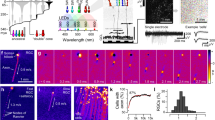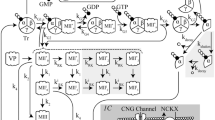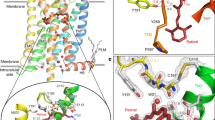Abstract
Photoreceptor cells in both vertebrates and invertebrates respond to a flash of light with a slow graded change in membrane potential, which is generally depolarising in invertebrates and hyperpolarising in vertebrates. Although some of the early photochemical and biochemical stages of the transduction process have been elucidated in both cases1,2, these reactions are fast compared with the time course of the electrical response, which is typically hundreds of milliseconds long. To explain this slow response in the eye of Limulus, Fuortes and Hodgkin3 proposed a mechanism in which the light signal passes through a cascade of simple low pass filters. The model was later defined more specifically in terms of a chain of chemical reactions linked together through products and reactants4, and has been used with small modifications and different numbers of stages to account for the behavior of various vertebrate and invertebrate photoreceptors including the fly compound eye5,6. I have now obtained evidence that phototransduction in the fly in small signal conditions involves underdamped resonance behaviour and a significant pure time delay, neither of which can be accounted for by the conventional cascade model.
This is a preview of subscription content, access via your institution
Access options
Subscribe to this journal
Receive 51 print issues and online access
$199.00 per year
only $3.90 per issue
Buy this article
- Purchase on Springer Link
- Instant access to full article PDF
Prices may be subject to local taxes which are calculated during checkout
Similar content being viewed by others
References
Hausen, K. in Function and Formation of Neural Systems (ed. Stent, G. S.) 81–110 (Dahlem Konferenzen, Berlin, 1977).
Kropf, A. in Vertebrate Photoreception (eds Barlow, H. B. & Fatt, P.) 15–28 (Academic, London, 1977).
Fuortes, M. G. F. & Hodgkin, A. L. J. Physiol., Lond. 172, 239–263 (1964).
Borsellino, A., Fuortes, M. G. F. & Smith, T. G. Cold Spring Harb. Symp. quant. Biol. 30, 429–443 (1965).
Baylor, D. A., Hodgkin, A. L. & Lamb, T. D. J. Physiol., Lond. 242, 685–727 (1974).
French, A. S. & Järvilehto, M. J. Physiol., Lond. 274, 311–322 (1978).
French, A. S. & Järvilehto, M. J. comp. Physiol. 126, 87–96 (1978).
French, A. S. I.E.E.E. Trans. biomed. Engng (in the press).
French, A. S. Biol. Cybernetics 32, 115–123 (1979).
D'Azzo, J. J. & Houpis, C. H. Feedback Control System Analysis and Synthesis (McGraw-Hill, New York, 1966).
Bendat, J. S. & Piersol, A. G. Measurement and Analysis of Random Data (Wiley, New York, 1968).
Author information
Authors and Affiliations
Rights and permissions
About this article
Cite this article
French, A. Phototransduction in the fly compound eye exhibits temporal resonances and a pure time delay. Nature 283, 200–202 (1980). https://doi.org/10.1038/283200a0
Received:
Accepted:
Issue Date:
DOI: https://doi.org/10.1038/283200a0
This article is cited by
-
Nonlinearization: naturalistic stimulation and nonlinear dynamic behavior in a spider mechanoreceptor
Biological Cybernetics (2018)
-
Equilibrating errors: reliable estimation of information transmission rates in biological systems with spectral analysis-based methods
Biological Cybernetics (2014)
-
Fast-acting compressive and facilitatory nonlinearities in light-adapted fly photoreceptors
Annals of Biomedical Engineering (1995)
-
Linear and non-linear contrast coding in light-adapted blowfly photoreceptors
Journal of Comparative Physiology A (1993)
-
Temporal resolving power of blowfly visual system: effects of decamethonium and hyperpolarization on responses of laminar monopolar neurons
Journal of Comparative Physiology A (1991)
Comments
By submitting a comment you agree to abide by our Terms and Community Guidelines. If you find something abusive or that does not comply with our terms or guidelines please flag it as inappropriate.



